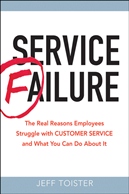An open letter to Mozy
 Jeff Toister
Jeff Toister  Saturday, June 12, 2010 at 11:10AM |
Saturday, June 12, 2010 at 11:10AM | Dear Mozy,
I’m writing this letter to you on my blog because you haven’t made it easy for me to contact you directly. You did respond to my Tweet on June 1 and said you’d get back to me, but you didn’t get back to me. I guess that’s the state of service these days – we have to make it public to get a response.
Here’s my gripe:
Sometime around May 28 your automatic online computer backup service stopped working. This is a real conflict with the positioning statement prominently featured on your website:
At Mozy, we believe: You shouldn’t have to think about backup. Backup should be set once, and then work automatically.
I've now had to think about backup and it didn't work automatically (or manually, for that matter). I’d be willing to cut you some slack if you handled it responsively, but you didn’t. You posted a few updates on your Community Support Forum, responded to a few Tweets, but that seems to be about it. I read some techno-babble about "load-balancing issues on your server", but I had to dig around your website just to get that. I tried to login to your support site so I could submit an trouble ticket (no email support, really?), but I couldn't because I got an error message there too.
My backups started running normally again on June 9 and I’m still a Mozy customer for now. However, I don’t think I’ll refer anyone else to you for a long time. And, this service failure has caused me to do what you said I shouldn’t have to: “think about backup”.
Do I have any better ideas? Yes.
- Communicate proactively. Let us know there’s a problem and what you are doing about it.
- Cast a wide net. Not everyone is going to troll through your support forum to find answers. Give us more options! Put updates on your home page. Send us emails. Give us the option to get automatic updates. Tweet timely updates. Make sure your support site login is working correctly. Give us email support.
- Be contrite. In my eyes, you’ve massively damaged your brand. Not just because of the service outage, but because of the way you handled it like it was just another technical glitch. What will you do to earn back my loyalty?
I hope you get it right Mozy!! I really do want to continue using your service but, like you said, I also don’t want to think much more about online backup.
Your friend?
Jeff







